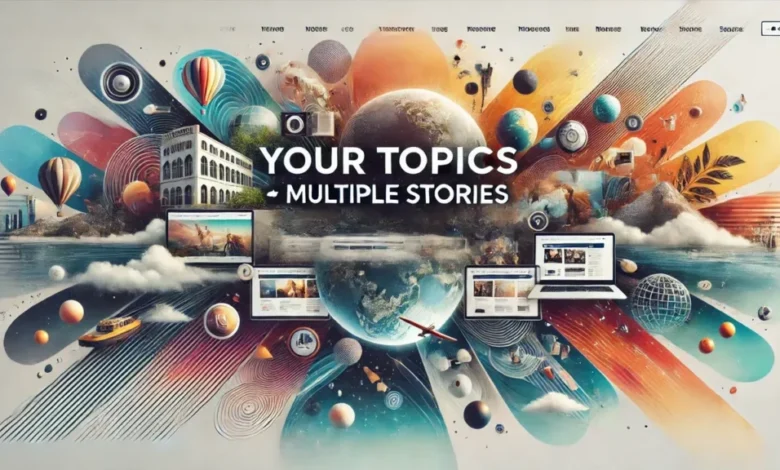Your Topics | Multiple Stories

Introduction to Multiple Narratives
Your Topics | Multiple Stories The concept of multiple narratives revolves around the idea that stories can vary significantly based on perspectives and contexts. Each individual brings their own background, experiences, and biases to a narrative, which ultimately shapes their understanding and interpretation of events. This multifaceted approach to storytelling enhances our comprehension of complex issues, emphasizing that no single viewpoint can encapsulate the entirety of a subject. By delving into various perspectives, we can uncover the rich tapestry of human experience that might otherwise remain hidden.
In exploring diverse perspectives, one begins to appreciate the nuances that accompany any given topic. For instance, a historical event may be celebrated as a triumph in one culture while being viewed as a tragedy in another. Such differences illuminate the importance of recognizing and valuing disparate stories, as they enrich our collective understanding. Engaging with multiple narratives allows us to see issues from different angles, fostering empathy and encouraging critical thinking.
The Power of Personal Stories
Personal stories carry a unique and profound power to engage and foster empathy among audiences. When individuals share their experiences, they provide insight into their inner worlds, allowing listeners or readers to connect on a deeper level. This connection is crucial, particularly in discussions around complex or sensitive topics where diverse perspectives are pivotal. Through narrative, personal experiences illuminate broader themes, making complex issues more relatable and understandable.
Moreover, personal anecdotes often resonate with listeners by evoking strong emotions. For instance, a story detailing an individual’s struggle with mental health can emphasize the importance of community support, thereby underscoring a larger conversation about mental wellness. This narrative technique cultivates an environment where audiences are not merely observers but participants, as they reflect on their own experiences and emotions in relation to the story being told. In this way, storytelling serves as a powerful bridge linking individual histories to collective issues.
Furthermore, personal stories can challenge stereotypes and preconceived notions associated with certain topics. By recounting their unique journeys, individuals can dismantle generalizations and expose the richness of diverse experiences. This is particularly relevant in discussions surrounding culture, identity, and social justice, where understanding multiple stories can lead to greater tolerance and awareness. Engaging with these narratives allows audiences to develop a more nuanced understanding of the complexities surrounding any given topic.
Ultimately, the integration of personal experiences into the conversation not only enriches the dialogue but also enhances the overall awareness of the subject matter. By encouraging individuals to share their stories, we open avenues for deeper connections and a greater appreciation of the diverse perspectives that shape our understanding of the world.
Cultural Perspectives: Diverse Voices
In addressing the theme of cultural perspectives, it is vital to recognize the rich tapestry of narratives that arise from diverse backgrounds. These stories often reflect unique values, beliefs, and experiences, allowing for a multifaceted understanding of prevalent topics. For instance, when exploring the concept of community, different cultures may emphasize various aspects of togetherness. In collectivist societies, the community’s well-being often takes precedence over individual desires, illustrating how societal norms shape personal identities and relationships.
Similarly, in discussions surrounding gender roles, narratives from distinct cultural contexts can unveil contrasting expectations and experiences. Certain cultures may endorse traditional gender norms, while others advocate for egalitarian structures. These variances contribute significantly to our understanding of gender-related topics, showcasing that there is no single story that encapsulates the complexities of human experience. By incorporating narratives from various cultural backgrounds, one can appreciate how cultural context influences interpretation and highlights the plurality of voice.
An illustrative example can be drawn from indigenous storytelling traditions, which often emphasize the interconnectedness of nature and humanity. In these cultures, stories serve not only as entertainment but also as educational tools that impart wisdom about environmental stewardship and community cohesion. This contrasts sharply with more individualistic cultures where personal success may overshadow communal values. Through these multiple stories, readers gain insights that enrich their comprehension of fundamental themes, showcasing that every narrative carries a distinct cultural message.
Ultimately, embracing cultural diversity in storytelling deepens our understanding of various topics, empowering us to learn from one another. Engaging with multiple stories cultivates empathy and fosters a greater appreciation for the complexities of life as seen through different cultural lenses.
The Role of Historical Context in Storytelling
Understanding storytelling necessitates an appreciation of the historical context within which narratives are developed. Historical events do not merely serve as backdrops; they play a fundamental role in shaping the themes, characters, and messages embedded in stories. The legacies of past occurrences influence current narratives, allowing contemporary audiences to draw parallels and glean insights that resonate with their modern experiences.
Take, for instance, the civil rights movement in the United States. Stories emerging from that era, whether in literature or film, serve as both reflections of the struggles faced by marginalized communities and cautionary tales that highlight the importance of social justice. When examining these narratives, it becomes evident how the historical context informs the interpretation of the stories being told. The plight for equal rights profoundly impacts how current discussions on racial equity are framed, reinforcing the notion that history often informs present-day viewpoints.
Moreover, the influence of historical context extends beyond the realm of social movements. In the case of classic literature, such as George Orwell’s “1984,” the story starkly reflects the anxieties of its time, encompassing themes of totalitarianism, surveillance, and individuality. The author’s experiences with politics during the early 20th century shaped the narrative, contributing layers of meaning that allow readers to engage with the text both as a product of its era and as a cautionary tale for future generations. Thus, one can observe that multiple stories on Your Topics | Multiple Stories are forever linked to their historical origins, revealing how our interpretative lens is shaped by the events that preceded us.
Challenges and Triumphs: Conflict in Stories
Conflict is an essential element in storytelling, serving as the catalyst for character development and plot progression. In numerous narratives, challenges are not merely obstacles but rather opportunities that shape the protagonist’s journey. These challenges often manifest in various forms, including interpersonal disagreements, internal struggles, and societal pressures, all contributing to a rich tapestry of multiple stories within a singular narrative framework. The presence of conflict compels characters to confront their fears, make significant choices, and ultimately grow, making the storytelling experience more relatable and compelling for audiences.
Consider the classic example of the hero’s journey where the protagonist faces a formidable antagonist. This conflict establishes a clear opposition, providing a narrative arc that is not only engaging but also allows the audience to explore themes of resilience and perseverance. As the character navigates these hurdles, the resolution of the conflict often reveals deeper insights about human nature and societal values. The triumph over adversity resonates with audiences, reinforcing the notion that challenges can lead to personal growth and triumphs, thereby enhancing the overall impact of the story.
Moreover, presenting Your Topics | Multiple Stories within a conflict enables a more nuanced understanding of the characters involved. By exploring various perspectives, the narrative can shed light on the motivations and backgrounds of all parties affected, fostering empathy among the audience. This balanced portrayal allows for a richer dialogue about morality, ethics, and the complexity of human relationships. It encourages audiences to reflect on their own experiences with conflict and draws parallels to the broader themes depicted in the story. Ultimately, the skillful integration of conflict into narratives not only captivates audiences but also serves as a powerful tool for exploration and understanding within the framework of multiple stories.
The Influence of Social Media on Storytelling
In recent years, social media has emerged as a pivotal medium for storytelling, significantly reshaping how narratives are crafted and shared. Platforms such as Twitter, Instagram, and TikTok have democratized the art of storytelling, allowing individuals from various backgrounds to present their experiences and viewpoints. This transformation has resulted in a rich tapestry of multiple stories on yYour Topics | Multiple Stories, facilitating global engagement and interaction.
Social media encourages user-generated content, where everyday individuals can narrate their personal stories alongside traditional media outlets. This shift has led to a more inclusive representation of diverse narratives, which often go unnoticed in mainstream media. For instance, hashtags such as #MeToo and #BlackLivesMatter have not only fostered conversation around significant societal issues but have also encouraged people to share personal accounts, thus amplifying marginalized voices. These narratives contribute to a collective understanding of pressing social dynamics, cultivating a strong sense of community among users.
Moreover, the interactivity that social media offers enables real-time feedback and discussion, allowing users to engage with stories in ways that were previously impossible. Comments, likes, and shares facilitate a dialogue that enhances storytelling. Storytellers are able to gauge audience reactions and adapt their narratives accordingly, leading to the emergence of new themes and perspectives. Thus, the stories that arise on social media platforms are often collaborative, shaped by the contributions and interactions of a diverse audience.
While the proliferation of social media has enriched storytelling, it presents challenges such as misinformation and the potential for oversimplification of complex issues. Nevertheless, it is evident that these platforms have profoundly influenced how stories are told and shared, highlighting the importance of various narratives on contemporary topics. This evolution in storytelling emphasizes the necessity for critical engagement and the appreciation of diverse perspectives.
Interconnected Stories: Building a Tapestry
Interconnected stories serve to enrich our understanding of various topics by providing multiple narratives that overlap and intersect. When distinct stories converge, they create a complex tapestry woven from different threads, each representing a unique perspective. This tapestry not only enhances the richness of our understanding but also encourages us to appreciate the multifaceted nature of the subject matter at hand. By considering multiple stories surrounding a single topic, one can begin to discern shared themes, contrasting viewpoints, and hidden connections that might otherwise remain obscured.
The interplay of these overlapping narratives can reveal insights and dimensions that challenge singular interpretations. For instance, in exploring societal issues, the experiences of individuals from various backgrounds can highlight both commonalities and disparities, showcasing how personal experiences reflect larger systemic phenomena. Through this lens, one can analyze economic, social, and cultural implications that are better understood through a holistic approach rather than a narrow viewpoint. Each narrative contributes to a deeper comprehension of the broader context, allowing individuals to recognize the complexity of societal constructs.
Moreover, embracing interconnected stories promotes empathy. By engaging with diverse perspectives, we become more attuned to the challenges faced by others, fostering inclusivity and understanding. This expanded viewpoint nurtures a more informed public discourse, encouraging constructive dialogue and collaboration among people with differing experiences and opinions. Integrating these varied narratives ultimately leads to more robust solutions to common challenges, as it draws upon a wealth of ideas, strategies, and insights. In pursuit of knowledge, acknowledging and exploring interconnected stories becomes essential for unraveling the intricate layers of our topics.
Lessons Learned from Multiple Stories
Engaging with multiple stories allows us to uncover valuable lessons that contribute to our broader understanding of complex topics. Each narrative serves as a unique lens, highlighting different experiences, perspectives, and insights. When stories from diverse backgrounds and contexts are considered, they collectively enrich our comprehension of the subject matter. This multifaceted approach emphasizes that there is rarely a singular truth; rather, multiple stories coexist, often intersecting and intertwining in meaningful ways.
One significant lesson that emerges is the importance of empathy. By interacting with a variety of storytelling modes, readers can step into the shoes of different individuals, recognizing their struggles, triumphs, and emotional landscapes. Such exercises in empathy foster a deeper connection to the human experience, encouraging us to look beyond our own viewpoints. This enriched understanding can inspire collective action and compassion, ultimately leading to a more inclusive society where diverse voices are valued.
Additionally, multiple stories highlight the interconnectedness of our lives. As we share different narratives, we begin to see recurring themes and challenges that link us all, regardless of our backgrounds. From these shared experiences, we can draw conclusions that reveal universal truths and foster collaboration across various sectors. The lessons derived from these interconnected stories can be applied in numerous real-world contexts, from community building to conflict resolution, illustrating that our stories often transcend their individual confines.
Ultimately, exploring multiple stories on Your Topics | Multiple Stories allows for a richer dialogue and a more robust understanding of the world around us. Each narrative contributes to a tapestry of knowledge that encourages critical thinking and promotes respect for diverse perspectives. By acknowledging and learning from these narratives, we can cultivate an informed mindset that appreciates the complexity of human experience.
Conclusion: Embracing Diversity in Storytelling
As we delve into the significance of storytelling within our discussions, it becomes increasingly evident that embracing diverse narratives greatly enhances our understanding of complex topics. Each narrative we encounter presents a unique lens through which we can examine shared issues, providing a more comprehensive viewpoint. The diverse stories from various backgrounds and cultures are not merely anecdotal but serve as fundamental building blocks of knowledge and empathy. They encourage richer dialogues and allow us to see the multifaceted nature of the human experience.
When we acknowledge and appreciate multiple stories around your topics, we expand our intellectual horizons, allowing for a more robust exploration of ideas. These varied narratives highlight not only the commonalities that bind us together but also the differences that enhance our individual experiences. In various discussions, integrating diverse perspectives can illuminate gaps in our understanding and inspire innovative solutions to shared problems. This holistic approach fosters an enriching environment where critical thinking thrives and creativity flourishes.
Moreover, in a world that is increasingly interconnected, the ability to engage with multiple viewpoints is paramount. By recognizing the value of diverse stories, we cultivate a culture of inclusivity that champions understanding and respect. This intentional act promotes social cohesion and creates opportunities for collaboration across different groups. Consequently, engaging with multiple stories is not just about representation; it is also about respect and the acknowledgment of each individual’s contribution to the collective narrative.
In conclusion, embracing diversity in storytelling is an essential practice that enriches discussions on your topics. By valuing multiple perspectives, we not only foster deeper insights but also pave the way for more compassionate and informed communities. The strength of our conversations lies in our willingness to listen to and learn from each other’s stories, ultimately leading to greater understanding and connectivity.
You May Also Read This Usamaketime.




